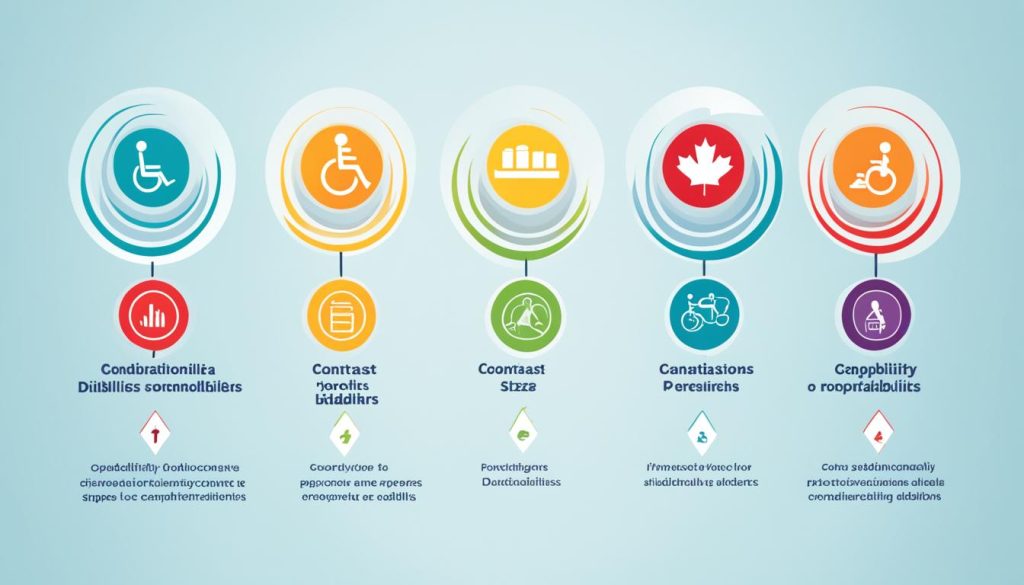Did you know that over 6.2 million Canadians live with a disability, accounting for nearly 22% of the population? Understanding the conditions that qualify for disability benefits in Canada is crucial for those seeking support to manage their everyday challenges. Whether you’re dealing with a physical, mental, or chronic health issue, the eligibility criteria can be complex and often misunderstood.
Navigating the disability landscape in Canada can be daunting, but with the right information, you can ensure you’re accessing the support you’re entitled to. In this comprehensive guide, we’ll explore the different types of disabilities that qualify for benefits, the Disability Tax Credit (DTC) eligibility criteria, and the ins and outs of the Canada Pension Plan (CPP) disability program. By the end, you’ll have a clearer understanding of what conditions are considered a disability in Canada and how to take the next steps towards securing the assistance you need.
The first step in determining if you qualify for disability benefits in Canada is understanding the eligibility criteria for the Disability Tax Credit (DTC). This federal tax credit is designed to provide financial assistance to individuals with severe and prolonged impairments that significantly restrict their ability to perform daily activities.
Understanding Disability Tax Credit (DTC) in Canada
The disability tax credit (DTC) is a crucial program in Canada that provides financial assistance to individuals with severe and prolonged disabilities. To be eligible for the DTC, a medical practitioner must certify that you meet specific eligibility criteria.
1. Eligibility Criteria for DTC
The key requirements for the DTC include having a severe and prolonged impairment. A severe impairment means you have a significant restriction in your ability to perform a basic activity of daily living. A prolonged impairment is one that has lasted, or is expected to last, for a continuous period of at least 12 months.
2. Severe and Prolonged Impairment
To qualify, your impairment must also be life-sustaining, meaning you require therapy to support a vital function, such as insulin to treat disability benefits canada. This ensures the disability criteria canada are met, and you can access the necessary disability support programs.
Marked Restrictions and Qualifying Categories
To qualify for the Disability Tax Credit (DTC) in Canada, you must demonstrate a marked restriction in at least one of the designated categories or significant limitations in two or more categories. These categories are essential in assessing your disability requirements and determining if you meet the criteria for the DTC.
1. Physical Impairments
A marked restriction in the physical category means that you are unable to perform a basic activity of daily living, such as walking, dressing, feeding, or eliminating (bowel or bladder functions), or require an inordinate amount of time to do so, even with appropriate therapy and the use of appropriate devices and medication. This marked restriction must be severe and prolonged, lasting for a continuous period of at least 12 months.
2. Mental Functions
The DTC also considers marked restrictions in mental functions, such as memory, problem-solving, goal-setting, and adaptive functioning. If you are unable to perform these mental activities or require an excessive amount of time to do so, even with appropriate therapy and the use of appropriate devices and medication, you may qualify for the DTC.

Alternatively, you may qualify for the DTC if you have significant limitations in two or more of the qualifying categories, even if you don’t meet the criteria for a marked restriction in any one category. This is known as the “cumulative effect assessment,” where the combined impact of your various impairments is considered.
Life-Sustaining Therapy
To qualify for the Disability Tax Credit (DTC) in Canada, you may also be eligible if you require life-sustaining therapy to support a vital function. This type of therapy is essential for sustaining a critical bodily function, such as insulin to manage diabetes or dialysis to treat kidney disease.
The criteria for life-sustaining therapy stipulate that you must need the therapy at least 3 times per week, for an average of at least 14 hours per week. This time commitment must be necessary to keep you alive and maintain your basic functioning. The therapy must be considered integral to your survival and well-being, without which your health would be severely compromised.
By meeting the requirements for life-sustaining therapy, you can demonstrate the significant and ongoing impact your condition has on your daily life, which is a key factor in qualifying for the DTC. This recognition can help alleviate the financial burden associated with managing your life-sustaining therapy and provide valuable tax credits to support your overall quality of life.
Combining Multiple Significant Limitations
If you do not meet the criteria for a marked restriction in any single category, you may still qualify for the Disability Tax Credit (DTC) if the cumulative effect of your significant limitations in two or more categories results in a marked restriction. Significant limitations refer to a substantial restriction in your ability to perform a basic activity of daily living, even with appropriate therapy and the use of appropriate devices and medication.
Cumulative Effect Assessment
The Canada Revenue Agency (CRA) evaluates the cumulative effect of your limitations across multiple categories to determine if the overall impact on your daily life qualifies you for the DTC. This assessment considers the combined effect of your restrictions, rather than focusing solely on individual categories. By taking this holistic approach, the CRA can recognize the significant challenges you face, even if no single impairment meets the marked restriction criteria on its own.
The key is to provide comprehensive medical documentation that illustrates the significant limitations you experience in your day-to-day activities. This evidence should demonstrate how the cumulative impact of your restrictions substantially impairs your ability to function independently, despite the use of appropriate aids and therapies.

By understanding the CRA’s approach to the cumulative effect assessment, you can ensure that your application for the DTC accurately reflects the full scope of your disability-related challenges. This holistic evaluation can be a crucial pathway to accessing the tax credit and other disability benefits that you may be entitled to in Canada.
What Conditions Qualify for Disability in Canada?
To qualify for disability benefits in Canada, individuals must have a mental or physical disability that regularly prevents them from engaging in any type of substantially gainful work. The disability must be long-term and of indefinite duration, or likely to result in death. Examples of conditions that may qualify for disability benefits in Canada include severe mental illnesses, neurological disorders, musculoskeletal conditions, and chronic illnesses such as cancer, heart disease, or diabetes.
1. Mental or Physical Disabilities
The disability can be either mental or physical in nature, as long as it significantly impairs the individual’s ability to perform any type of substantially gainful work on a regular basis. This includes conditions such as schizophrenia, bipolar disorder, Parkinson’s disease, multiple sclerosis, and amputations.
2. Long-Term or Indefinite Duration
To qualify for disability benefits, the condition must be long-term and of indefinite duration, or likely to result in death. This means the disability must have lasted, or be expected to last, for a continuous period of at least 12 months. Chronic illnesses that meet this criteria, such as disability pension canada and disability services, may also be eligible for disability benefits.
Canada Pension Plan (CPP) Disability Benefits
The CPP disability benefit is a monthly payment available to individuals under the age of 65 who have contributed enough to the Canada Pension Plan and have a mental or physical disability that regularly stops them from doing any type of substantially gainful work. This cpp disability benefit can provide essential financial support for those facing long-term or indefinite disabilities.
1. CPP Post-Retirement Disability Benefit
For individuals between the ages of 60 and 65 who are already receiving the CPP retirement pension, the cpp post-retirement disability benefit may be available if they meet the disability criteria. This benefit can help bridge the gap for those who develop a disability later in their careers.
2. CPP Children’s Benefit
If you are receiving a CPP disability benefit, your dependent children may also be eligible for the cpp children’s benefit. This monthly payment can provide additional support for families navigating the challenges of disability.

Quebec Pension Plan Disability Benefits
If you are a resident of Quebec, you would not apply for the disability benefit under the Canada Pension Plan (CPP). Instead, you can apply for the Quebec Pension Plan (QPP) disability benefit if you meet certain criteria. To be eligible, you must have worked only in the province of Quebec, currently live in Quebec and have worked both in the province of Quebec and in another province or territory, or have worked in Quebec and currently live outside Canada, with your last province of residence being Quebec.
The QPP disability benefit provides financial support for individuals with a mental or physical disability that regularly prevents them from doing any type of substantially gainful work. The disability must be long-term and of indefinite duration, or likely to result in death, similar to the criteria for the CPP disability benefit.
Applying for the QPP disability benefit involves providing documentation and medical evidence to support your claim. This may include medical reports, test results, and statements from healthcare professionals detailing your condition, symptoms, and the impact on your ability to work. The application process can be complex, and it’s recommended to seek assistance from a disability advocate or lawyer if needed.
If you are approved for the QPP disability benefit, it can provide you with a monthly payment to help manage your disability and maintain your quality of life. It’s important to note that the QPP disability benefit is separate from the CPP disability benefit, and the eligibility criteria and payment amounts may differ between the two programs.
CPP Disability Benefits for Children
In addition to the Canada Pension Plan (CPP) disability benefits available to adults, there are two types of CPP benefits specifically designed for children whose parents have disabilities. These include the Surviving Child’s Benefit and the Disabled Contributor’s Child’s Benefit.
The Surviving Child’s Benefit is a monthly payment provided to the child of a deceased CPP contributor who made sufficient contributions before passing away. This benefit helps support the child’s care and well-being during a difficult time.
The Disabled Contributor’s Child’s Benefit, on the other hand, is a monthly payment for the child of a person who is currently receiving the CPP disability benefit. This assistance helps ensure the child’s needs are met while their parent or guardian navigates the challenges of a disability.
These specialized CPP benefits for children demonstrate the comprehensive approach Canada takes to supporting families affected by disability. By providing financial assistance to the children of disabled or deceased contributors, the government aims to alleviate the burden and ensure the surviving child’s benefit and disabled contributor’s child’s benefit are accessible to those who need it most.
Applying for Disability Benefits in Canada
When applying for disability benefits in Canada, you will need to provide thorough documentation and medical evidence to support your claim. This documentation may include comprehensive medical reports, detailed test results, and statements from your healthcare professionals outlining your condition, symptoms, and the significant impact on your ability to work.
The application process for disability benefits can be complex, so it’s highly recommended to seek assistance from a disability advocate or lawyer if needed. They can guide you through the intricate requirements and ensure your submission contains all the necessary documentation and medical evidence to strengthen your case.
Compiling this supporting information can be a time-consuming task, but it’s essential to demonstrate the severity and long-term nature of your disability. By taking the time to thoroughly document your condition, you can increase your chances of successfully applying for disability benefits in Canada and accessing the financial support you require.
Retirement Planning and Disability Benefits
If you are receiving disability benefits, it’s important to consider how this may impact your retirement planning. Disability benefits may be considered as part of your overall retirement income, and the eligibility criteria and payment amounts can change over time. It’s recommended to work with a financial advisor to ensure your retirement plan accounts for any disability benefits you may be receiving.
When incorporating disability benefits into your retirement planning, it’s crucial to stay informed about any potential changes to the program. The eligibility requirements and payment amounts for disability benefits can evolve over time, so it’s essential to regularly review your situation and make adjustments to your retirement plan as needed.
Collaborating with a financial advisor can help you navigate the complexities of retirement planning and disability benefits. They can provide valuable insights on how to optimize your financial strategy, ensure that your disability benefits are properly accounted for, and help you make informed decisions about your long-term financial well-being.
| Retirement Planning Considerations | Disability Benefit Factors |
|---|---|
| Income sources | Eligibility criteria |
| Investment strategies | Payment amounts |
| Tax implications | Potential changes over time |
| Withdrawal strategies | Integration with other benefits |
By proactively addressing the relationship between retirement planning and disability benefits, you can ensure that your financial strategy is comprehensive and tailored to your unique needs and circumstances. This approach can help you navigate the challenges and opportunities associated with managing your long-term financial well-being.

Conclusion
In conclusion, understanding the conditions that qualify for disability in Canada is essential for individuals seeking to access disability benefits and tax credits. The eligibility criteria focus on severe and prolonged impairments, marked restrictions in daily activities, and the need for life-sustaining therapy. While the most approved disability in Canada may vary, the key is to navigate the application process diligently and provide the necessary medical evidence to support your claim.
By knowing the requirements and working closely with healthcare professionals, individuals can access the support they need to manage their disabilities and maintain their quality of life. Whether it’s a physical or mental condition, the disability support programs in Canada aim to provide the necessary resources and assistance to those in need.
Ultimately, the most important factor is to seek the appropriate guidance and take the necessary steps to ensure you receive the benefits and accommodations you are entitled to. By staying informed and proactive, individuals can navigate the complex landscape of disability support in Canada and achieve the best possible outcomes for their personal and financial well-being.
FAQ
1. How do I know if my car seat is expired in Canada?
The expiration date can typically be found on a sticker on the bottom of the car seat or stamped into the plastic frame. If the expiration date is not visible, you should consult the car seat manual for the specific expiration information.
2. Is it illegal to use an expired car seat in Canada?
While there are no specific laws prohibiting the use of expired car seats in Canada, it is strongly recommended to replace car seats before the expiration date. Expired car seats may not provide the same level of safety and protection in the event of an accident.
3. What is the lifespan of car seats in Canada?
The lifespan of car seats in Canada can vary depending on the manufacturer, but typically ranges from 6 to 10 years. Factors such as the specific model, whether parts were sold separately, and the date of manufacture or purchase can affect the expiration date.
4. How long can you use a car seat in Canada?
The recommended lifespan for car seats in Canada is typically between 6 to 10 years, depending on the manufacturer. It is important to replace the car seat before the expiration date to ensure the safety and effectiveness of the seat.
5. When should I stop using an infant car seat in Canada?
The recommended guidelines in Canada suggest that infants should remain rear-facing until they reach the maximum height and weight limits of their infant car seat, usually around 2 years of age. At this point, they can transition to a forward-facing car seat or a convertible car seat that can be used rear-facing and forward-facing.
6. Do strollers expire in Canada?
Unlike car seats, strollers in Canada do not have a defined expiration date. However, it is important to regularly inspect strollers for any signs of wear, damage, or safety issues, and to replace them if necessary to ensure the continued safety of your child.
7. When do car seats expire in Canada?
The expiration date for car seats in Canada can vary widely depending on the manufacturer, typically ranging from 6 to 10 years. It is crucial to check the expiration date on the specific car seat you own, as it may not align with the typical timeframes for that brand or product type.




